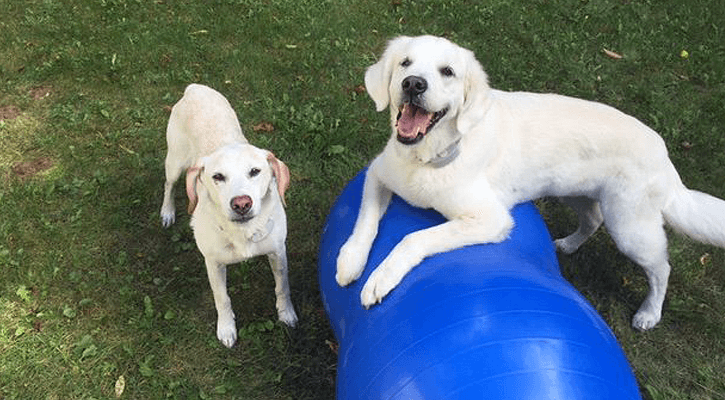
Rehabilitation & Fitness
Pet rehabilitation and fitness services performed are at our Elk Rapids location.
Disease and injury can be painful and lead to chronic conditions which may inhibit mobility and become debilitating. These conditions can be as subtle as postural changes caused by aging, or acute injury.
Canine rehabilitation performed by a certified professional is an effective way to help your dog heal from injury and return to function in a shorter amount of time. Although commonly utilized for post-surgical healing, rehabilitation can be helpful for a variety of other conditions and is a key component in preventing injury. Our new rehabilitation facility in Elk Rapids Animal Hospital is ready to help your pet. We have a highly experienced team looking forward to offering an integrative approach to healing; two veterinarians certified in canine rehabilitation therapy: Dr. Ashley Schroeder and Dr. Jenn Rudnick. We also have Missi Campbell, LVT, CCRP who has a certification in Physical Rehabilitation and Sara, a certified canine rehabilitation assistant, who is also certified in canine massage. With several years of combined experience, our rehab team looks forward to offering an integrative approach to healing
Services Offered
These Services Are Only Offered in Our Elk Rapids Office
Massage & Stretching
The benefits of massage have been well documented in human and animal medicine. A therapeutic massage will open blood vessels to improve circulation, enhance relaxation, ease trigger points, and potentially help the therapist locate troublesome areas.
Therapeutic Laser
Low level laser therapy is a non-invasive tool that boosts cell metabolism and increases circulation. Some of the numerous benefits include: bone repair, wound healing, reduction of inflammation, and tendon/ligament repair. LLL Therapy can also improve nerve function by enhancing nerve cell connection and regeneration. Treatments last 5-20 minutes and can be quite relaxing!
Laser Therapy
There are many different types of lasers.
Benefits of MLS Laser Therapy
- Relief of chronic pain, such as arthritis
- Relief of acute pain, such as trauma or injury
- Strong anti-inflammatory effect
- Stimulates healing of damaged tissue
- Speeds recovery of the structural integrity of injured region
- Improvement of local blood circulation
- Postoperative pain relief and faster wound healing
Conditions Commonly Treated with MLS Laser Therapy
- Arthritis Pain
- Post-Surgery and Wound Healing
- Tendonitis
- Lick Granuloma
- Inflamed Ears (chronic or acute ear infections)
- Hip Dysplasia
- Intervertebral Disc Disease
What is laser therapy?
Laser therapy is the use of specific wavelengths of light to treat painful and debilitating conditions.
How does laser therapy work?
Light energy enters the damaged cells and stimulates inter-cellular activity. This reduces pain in the area and speeds recovery of the damaged cells. Once the cells recover, the healing process is complete.
What can my pet expect during a treatment?
MLS Laser Therapy is a painless treatment that lasts an average of 3-8 minutes. Your pet may experience a comfortable sensation at the point of application.
What can be expected after the treatment?
Most patients see positive results in one to three treatments. Acute conditions can subside with as few as one set of treatments. Chronic conditions can be managed with regular bi-weekly or monthly treatments. And there are no known negative side effects. Often, pain medications can be reduced or eliminated after MLS Laser Therapy treatment.
Balance & Proprioception Training
Balance work helps the patient maintain their center of gravity while working on strengthening different regions/muscles. As you may know, the more balance we have, the less we fall down! Proprioception work helps the patient understand where/how their feet are placed while standing and walking. Some orthopedic and neurologic conditions can interrupt nerve “messages” that control feet placement. During this interruption, a patient may experience further injury or delayed healing. Specific exercises can help retrain the limb while strengthening it at the same time.
Therapeutic Plan Development & Implementation Training
Some of the most challenging exercises may seem easy to you and me, but to an injured patient they can actually be quite difficult. One of the most valuable tools in veterinary rehabilitation is the creation of a specific exercise (or group of exercises) for a patient’s specific condition. Because conditions change, the performance of these exercises are monitored closely and tailored as changes occur. As part of the planning process, training for the human counterpart is a necessity and hands on guidance is available every step of the way. Most dogs find the exercise sessions so much fun that we can hardly call it exercise!
TENS
An application of electrical current through the skin, transcutaneous electrical nerve stimulation (TENS) is used primarily to manage pain. A small, battery operated TENS unit delivers an electrical current through the skin and provides temporary pain relief.
Hydrotherapy (Underwater Treadmill)
The combination of warm water, buoyancy, and resistance creates improved joint range of motion, endurance, muscle development, and heightened proprioception for neurological re-education. Each treadmill session is personalized by adjusting the treadmill speed, water height, time, and distance. Some patients may benefit from just swimming in the tank with higher levels of water. **Certain rules apply** Please contact our therapists to ensure this will be a safe means of exercise for your pet.
Pet Rehabilitation Therapy in Suttons Bay, MI
If you have questions or would like additional information about our pet rehabilitation therapy in Suttons Bay, please feel free to contact our rehabilitation center at [email protected]
Keep up with the rehab team by following our Facebook page!
